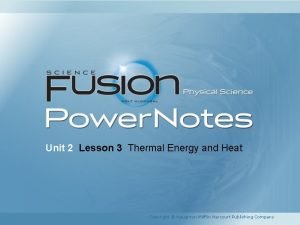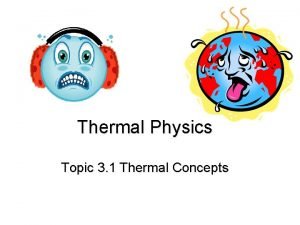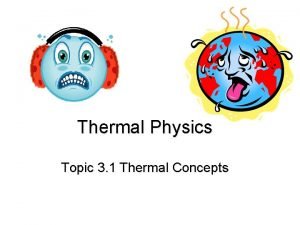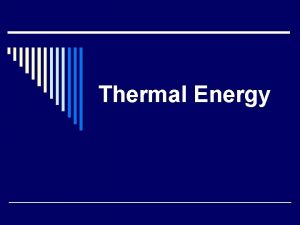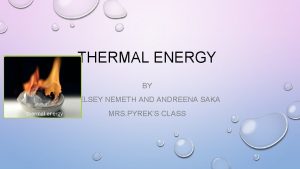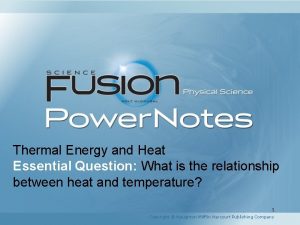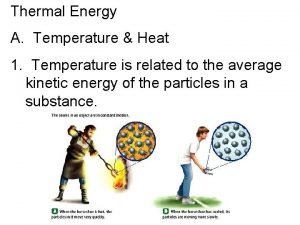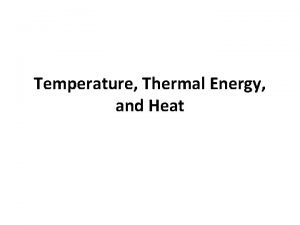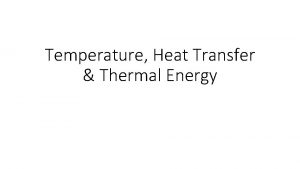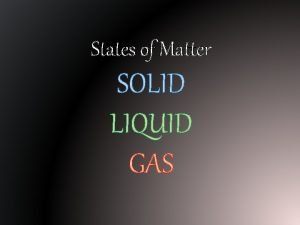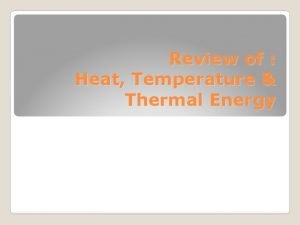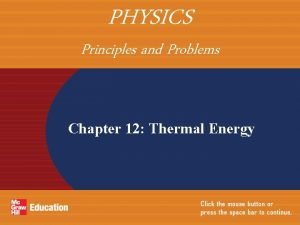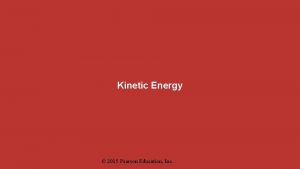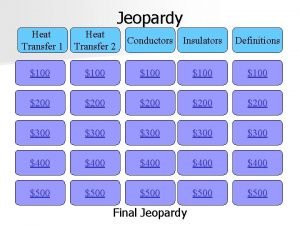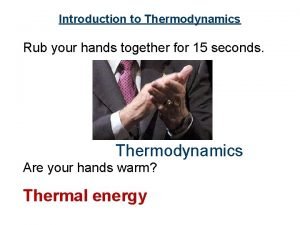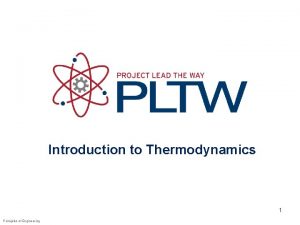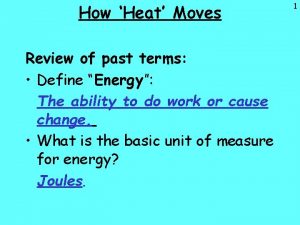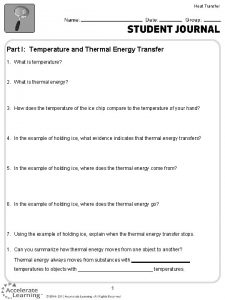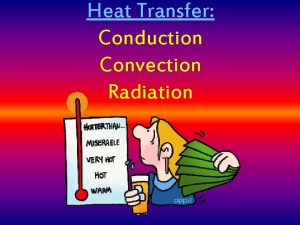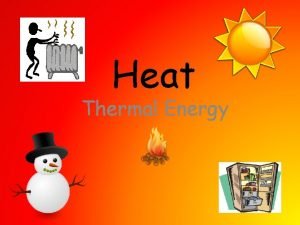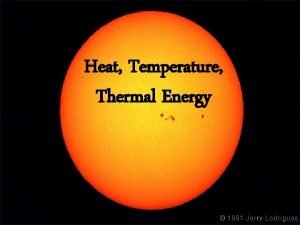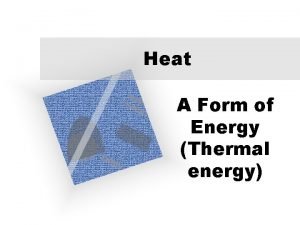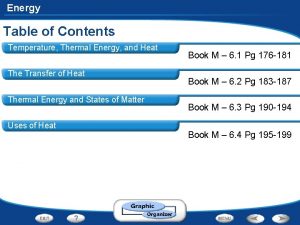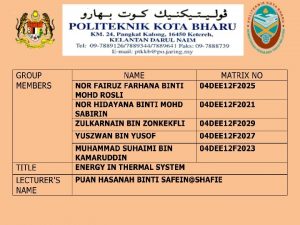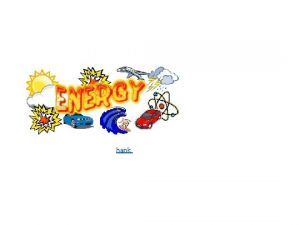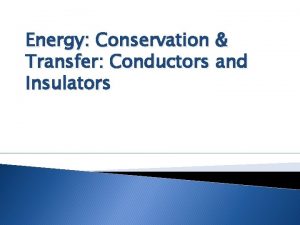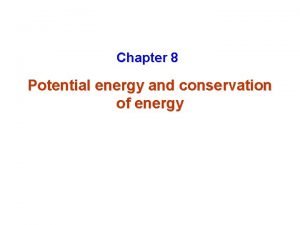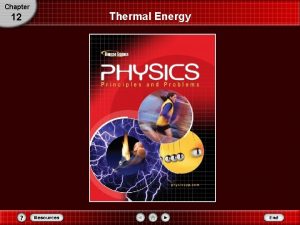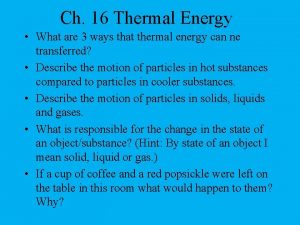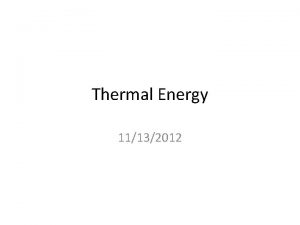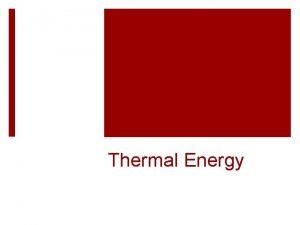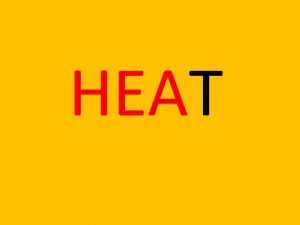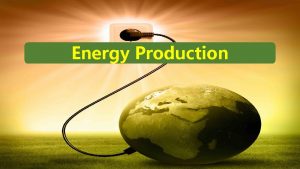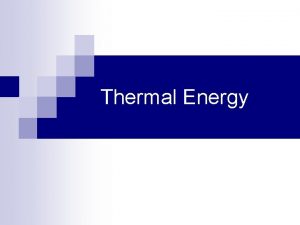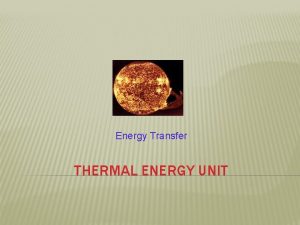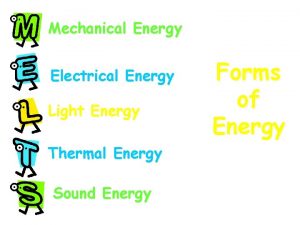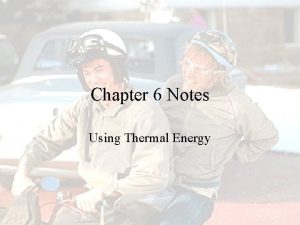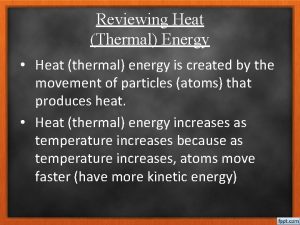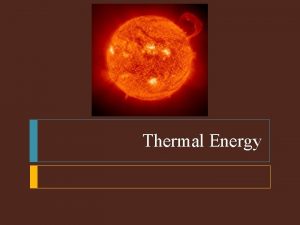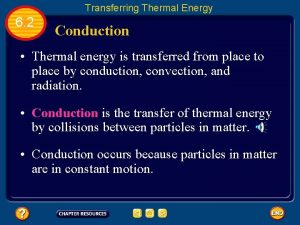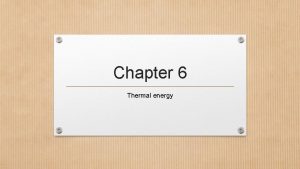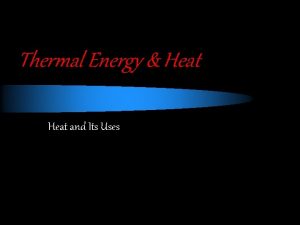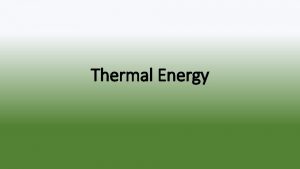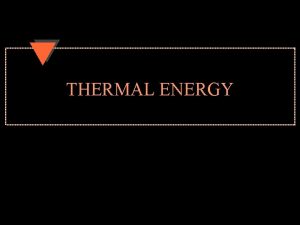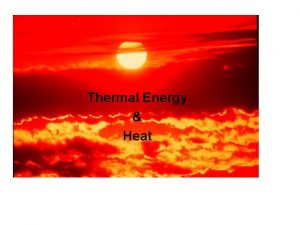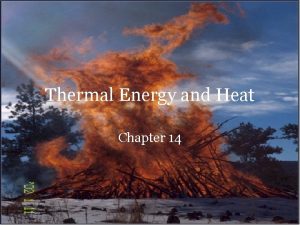Ch 16 Thermal Energy What are 3 ways








































- Slides: 40

Ch. 16 Thermal Energy • What are 3 ways that thermal energy can ne transferred? • Describe the motion of particles in hot substances compared to particles in cooler substances. • Describe the motion of particles in solids, liquids and gases. • What is responsible for the change in the state of an object/substance? (Hint: By state of an object I mean solid, liquid or gas. ) • If a cup of coffee and a red popsickle were left on the table in this room what would happen to them? Why?

Thermal, Under Where? What is thermal energy? • Thermal energy is the total kinetic energy of all particles in a substance. • Thermal energy is measured in joules (J). 2

Unit 2 Lesson 3 Thermal Energy and Heat p 124 What is the difference between thermal energy and temperature? • Temperature is related to the average kinetic energy of particles. • Thermal energy is the total kinetic energy of all the particles. • For example, a glass of water can have the same temperature as a lake, but the lake has much more thermal energy because the lake contains many more water molecules. ***Temperature and total amount of particles determine thermal energy of a substance.

Heat It Up! What is heat? • Heat is the energy transferred from an object at a higher temperature to an object at a lower temperature. • Heat is Thermal Energy is transit! • Energy in the form of heat always flows from hot to cold. 4

Draw an arrow in the direction in which energy in the form of heat would flow. Object 1 Direction of heat flow Object 2 Metal rod Fire Hat Snowman Ice cube Glass of warm water (As in 3 -Dimensional frozen squares, not the rapper/Actor) 5

How is heat measured? • In nutrition, 1 Calorie (with a capital C) is actually 1 kilocalorie, or 1, 000 calories. • To find out how many calories are in food, a sample of food is burned inside an instrument called a calorimeter. • The change in temperature in the calorimeter is used to calculate how much energy is released from the food sample. 6

How is heat related to thermal energy? • Adding or removing heat from a substance will affect its temperature and thermal energy. • Heat, however, is not the same as thermal energy and temperature. • Thermal energy and temperature are properties of a substance. Heat is the energy involved when these properties change. • Even though two materials might have the same temperature, their thermal energies might be different. • Thermal energy depends on how many particles are present in the object. Energy as heat will be transferred from the warmer object to the cooler object until both objects are at the same temperature AKA reach temperature equilibrium.

Which has more thermal energy? Bowl of Soup Small balloon Tiger Pot of Soup Large balloon House cat 8

How can heat affect the state of an object? • The state of a substance depends on the speed of its particles. • Adding energy in the form of heat to a substance can result in a change of state. • Removing energy in the form of heat from a substance can also result in a change of state. 9

Understanding Heat Transfer, Conduction, Convection and Radiation

Heat Transfer • Heat always moves from a warmer place to a cooler place. • Hot objects in a cooler room will cool to room temperature. • Cold objects in a warmer room will heat up to room temperature.

Question • If a cup of coffee and a red popsickle were left on the table in this room what would happen to them? Why? • The cup of coffee will cool until it reaches room temperature. The popsickle will melt and then the liquid will warm to room temperature.

Energy as heat can be transferred in three main ways: conduction, convection, and radiation. 13

Keep Your Cool What is conduction? • Conduction is the transfer of energy as heat from one substance to another through direct contact. • As long as two objects are in contact, conduction continues until the temperatures of the objects are equal. 14

Conduction When you heat a metal strip at one end, the heat travels to the other end. As you heat the metal, the particles vibrate, these vibrations make the adjacent particles vibrate, and so on, the vibrations are passed along the metal and so is the heat. We call this? Conduction

Metals are different The outer electrons _______ of metal atoms drift, and are free to move. When the metal is heated, this ‘sea of kinetic electrons’ gain ______ energy and transfer it throughout the metal. plastic do not wood and ______, Insulators, such as ____ have this ‘sea of electrons’ which is why they do not conduct heat as well as metals.

Why does metal feel colder than wood, if they are both at the same temperature? Metal is a conductor, wood is an insulator. Metal conducts the heat away from your hands. Wood does not conduct the heat away from your hands as well as the metal, so the wood feels warmer than the metal.

What is conduction? • A conductor is a material that transfers heat very well. • An insulator is a material that is a poor conductor of heat. • Metals are typically good • Wood, paper, and plastic foam conductors. are examples of good insulators. 18

Flannel Shirt • conductor • insulator Iron skillet • conductor • insulator Copper pipe • conductor • insulator Oven Mitt • conductor • insulator 19 Copyright © Houghton Mifflin Harcourt Publishing Company

What is convection? • Convection is the transfer of energy as heat by the movement of a liquid or gas. • Convection occurs when a cooler, denser mass of gas or liquid replaces a warmer, less dense mass of gas or liquid by pushing it upward. • When water is boiled, the water moves in roughly circular patterns because of convection. • This motion is due to density differences that result from temperature differences. • The motion is called a convection current. 20

Convection What happens to the particles in a liquid or a gas when you heat them? HEAT The particles spread out and become less dense. This effects What A liquid isfluid aorfluid? gas. movement.

Fluid movement dense fluids Cooler, more _____, warmer less sink through ______, dense fluids. In effect, warmer liquids and rise up. gases ____ sink Cooler liquids and gases ____.

Water movement Cools at the surface Cooler water sinks Convection current Hot water rises

Convection 24

Why is it windy at the seaside?

Cold air sinks Where is the freezer compartment put in a fridge? It is put at the top, because cool air sinks, so it cools the food on the way down. Freezer compartment It is warmer at the bottom, so this warmer air rises and a convection current is set up.

The third method of heat transfer How does heat energy get from the Sun to the Earth? ? There are no particles between the Sun and the Earth so it CANNOT travel by conduction or by convection. RADIATION

What is radiation? • Radiation is the transfer of energy by electromagnetic waves. • Examples of EM waves: visible light, microwaves, infrared light • When radiation is emitted from one object and then absorbed by another, the result is the transfer of heat. • Radiation can travel through empty space. 28

Radiation travels in straight lines True/False Radiation can travel through a vacuum True/False Radiation requires particles to travel True/False Radiation travels at the speed of light True/False

Practical Uses of Radiation • A solar cooker is a device that cooks food using mirrors that concentrate radiation from the sun. • In parts of the world that are far from electricity and clean water, solar cookers are a cheap and portable way to sterilize water for drinking. • Many people like to use solar cookers because they do not require any fuel and do not release harmful emissions. 30 Copyright © Houghton Mifflin Harcourt Publishing Company

Example Conduction, convection or radiation When you put some food in the microwave, it gets hot. conduction A heater on the first floor of the school makes the air on the second floor warm 31

Emission experiment Four containers were filled with warm water. Which container would have the warmest water after ten minutes? Dull metal Shiny black Dull black shiny metal container would be the warmest after ten The _____ radiation back minutes because its shiny surface reflects heat _______ dull black container into the container so less is lost. The ____ emitting heat would be the coolest because it is the best at _______ radiation.

Absorption experiment Four containers were placed equidistant from a heater. Which container would have the warmest water after ten minutes? Dull metal Shiny black Dull black dull black container would be the warmest after ten The _____ radiation the best. minutes because its surface absorbs heat _______ shiny metal container would be the coolest because it is The _____ the poorest at _____ absorbing heat radiation.

Radiation questions Why are houses painted white in hot countries? White reflects heat radiation and keeps the house cooler. Why do dome roofs have more frost on them than others even though they are receiving the same amount of sunlight? The houses with more frost have better insulation so the heat from the house stays trapped in, instead of escaping through the roof and melting the frost like the others. Why are shiny foil blankets wrapped around marathon runners at the end of a race? The shiny metal reflects the heat radiation from the runner back in, this stops the runner getting cold.

Heat is the transfer of Thermal energy by Conduction Convection Radiation 35

1. Which of the following is not a method of heat transfer? A. Radiation B. Insulation C. Conduction D. Convection

2. In which of the following are the particles closest together? A. Solid B. Liquid C. Gas D. Fluid

3. How does heat energy reach the Earth from the Sun? A. Radiation B. Conduction C. Convection D. Insulation

4. Which is the best surface for reflecting heat radiation? A. Shiny white B. Dull white C. Shiny black D. Dull black

5. Which is the best surface for absorbing heat radiation? A. Shiny white B. Dull white C. Shiny black D. Dull black
 Antigentest åre
Antigentest åre Section 3 using thermal energy answers
Section 3 using thermal energy answers How are thermal energy and temperature different
How are thermal energy and temperature different Thermal energy and mass
Thermal energy and mass Thermal transfer vs direct thermal printing
Thermal transfer vs direct thermal printing Gods ways are not our ways
Gods ways are not our ways Energy energy transfer and general energy analysis
Energy energy transfer and general energy analysis Energy energy transfer and general energy analysis
Energy energy transfer and general energy analysis Difference between heat and thermal energy
Difference between heat and thermal energy Conduction or convection
Conduction or convection Specific heat capacity of lead j/kg c
Specific heat capacity of lead j/kg c Difference between heat and thermal energy
Difference between heat and thermal energy Thermal energy in states of matter
Thermal energy in states of matter Thermal energy depends on
Thermal energy depends on What is todays temperature
What is todays temperature Thermal energy definition
Thermal energy definition Flannel shirt conductor or insulator
Flannel shirt conductor or insulator Energy and temperature
Energy and temperature How to measure heat energy
How to measure heat energy Example of heat energy
Example of heat energy Thermal energy states of matter
Thermal energy states of matter Heat thermal energy and temperature
Heat thermal energy and temperature Chapter 12 study guide thermal energy
Chapter 12 study guide thermal energy Quesiton
Quesiton Heat transfer jeopardy
Heat transfer jeopardy Energy transfer rubbing hands together
Energy transfer rubbing hands together Thermal energy formula
Thermal energy formula Define thermal energy
Define thermal energy Types of thermal energy transfers
Types of thermal energy transfers Type of thermal energy transfer
Type of thermal energy transfer Thermal vs heat energy
Thermal vs heat energy Heat thermal energy and temperature
Heat thermal energy and temperature Thermal heat formula
Thermal heat formula Heat vs thermal energy vs temperature
Heat vs thermal energy vs temperature Kesimpulan energy in thermal system
Kesimpulan energy in thermal system Energy videos bill nye
Energy videos bill nye Thermal energy examples
Thermal energy examples Thermal energy equation
Thermal energy equation Chapter 12 thermal energy answers
Chapter 12 thermal energy answers Thermal energy and mass
Thermal energy and mass 3 ways heat travels
3 ways heat travels








